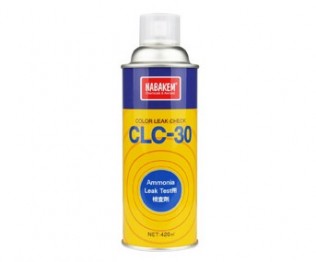NABAKEM CLC-30 Color Leak Check Spray 420ML
Price: $19.26
Price shown above are inclusive of GST
Price shown above are inclusive of GST
Features
• Very fine defect may be detected.
• Defects found easily with naked eyes.
• Color is changed(Yellow→Blue)
• No harmful for paint or metal.
Use
|
Directions for usage
 |
| • Permance of indication Indication maintains permance over 24 hours by ammonia gas fillup alone. When fillup gas is removed or temperature is over 70℃, decoloration occurs. Use the product below 40℃. • Influences of moisture When CLC-30 is combined with adhesive water or moisture, it becomes weak-acid to create corrosion. Remove moisture completely. • Welding slag residual As covering materials of covered welding rod contains strong-alkaline components like water and glass, application of CLC-30 shows pseudo-decoloration as if there are cracks. Neutralize the product with cleaner before inspection or remove the residues with wire brush. However, the residues do not cause any problems with CO2 weld not using flux, TIG weld, MIG weld and submerged arc weld using meting flux. • Residual of oil in enlarged tube Weld between tube and tube plate of heat exchanger or boiler has alkaline materials of lubricants used for tube expansion, which tend to cause pseudo-discoloration. The materials should be removed. Also oil remained in tube can not be removed easily. It is highly recommended that cylinder oil or neutral lubricant of turbine oil should be used. • Influences of surfactant When test is done by CLC-30 after air test, alkaline surfactant (detergent) is used for soap water for air test. Even if it is neutral, it shows alkalinity by thermonolysis and tends to cause pseudo-discoloration. Inpsection surface should be clean. Or right surfactant should be selected. Or surfactant should be removed completely for inspection. • Toxicity of solvent Low-toxic solvent is used. Provide good ventilation when using it in copious qantity indoors. • When using it at low temperature (above 5℃) Spraying it below 5℃, sprayed particles are thick and not applied evenly. In this case, dip it in warm water at 20℃ ∼ 30℃ before use.(Be careful to prevent temperature from being above 40℃.) • This flammable product uses high-pressure gas. • Comply with following cautions. 1. Do not spray it toward flame. 2. Do not use it near stove and heater. 3. Do not use it in the room using fire. 4. Do not keep in the place above 40℃ 5. Provide ventilation after using it in closed room. 6. Do not throw it into fire. 7. Punch the can after use and remove residual gas to throw it away. 8. Do not keep it in the closed place. |



